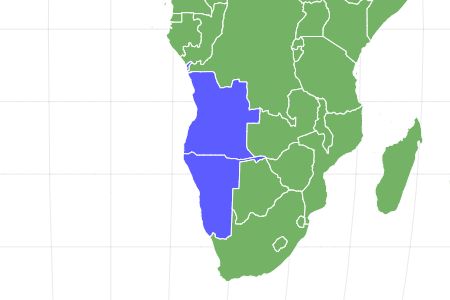Peringuey’s Adder
Bitis peringueyi
Peringuey's adders' eyes are nearly on the tops of their heads!
Advertisement
Peringuey’s Adder Scientific Classification
- Kingdom
- Animalia
- Phylum
- Chordata
- Class
- Reptilia
- Order
- Squamata
- Family
- Viperidae
- Genus
- Bitis
- Scientific Name
- Bitis peringueyi
Read our Complete Guide to Classification of Animals.
Peringuey’s Adder Conservation Status
Peringuey’s Adder Facts
- Prey
- Lizards and geckos
- Main Prey
- Lizards from the Meroles genus.
- Group Behavior
- Solitary
- Fun Fact
- Peringuey's adders' eyes are nearly on the tops of their heads!
- Most Distinctive Feature
- Eyes on the top of their head!
- Distinctive Feature
- Strongly keeled scales that give it an almost furry appearance.
- Other Name(s)
- Peringuey's adder, Peringuey's desert adder, sidewinding adder, Namib dwarf sand adder, dwarf puff adder, Namib desert sidewinding adder, dwarf sand adder, Namib dwarf adder, and Namib desert viper.
- Habitat
- Desert
- Diet for this Fish
- Carnivore
- Lifestyle
- Diurnal
- Favorite Food
- Lizards from the Meroles genus
View all of the Peringuey’s Adder images!
Peringuey’s adders live only in the Namib Desert of Namibia and Angola, where only the most creative creatures survive.
Peringuey’s adders live in a very narrow strip of land in the Namib Desert, where the sand is so soft that only a particular form of locomotion will do for this unique snake: sidewinding. They are small, thick-bodied desert specialists. Peringuey’s adders bury themselves in the sand, leaving only their eyes and sometimes tails visible. Peringuey’s adders are especially suited to desert-living. They have several terrific adaptations that make them successful in an unforgiving environment.
3 Amazing Facts About Peringuey’s Adder
- They average just 8-10 inches long, making Periguey’s adder one of the smallest viper species in the world.
- Instead of slithering forward, they move sideways, only touching the hot sand with a small part of their bodies at a time.
- Peringuey’s adders lick moisture from their scales, but most of their water comes from the lizards they eat.
Where to find Peringuey’s Adder
This species specializes in desert living in the soft sand of the Namib Desert on the west coast of southern Africa in Namibia and Angola. You’re most likely to find them buried in the sand or sidewinding their way across the wind-swept dunes. The only evidence of the snakes’ existence is their eyeballs sticking out of the sand where they’ve buried themselves.
The desert they inhabit is dry, so dry that, on average, it only receives .5 to 2 inches of rain per year. In some years, there is no rain at all. There is, however, the persistent fog that the animals here have found ways to use for their survival. In the early morning, you may find them licking the water that collected on their body. The fog that moves in from the Atlantic Ocean is thick and sometimes over 1000 feet deep.
Peringuey’s adders are lizard-eating connoisseurs that prefer sand lizards from the Meroles genus and barking geckos. They are ambush predators that do not chase down their prey. Instead, they use their ability to bury themselves in the sand to wait for their meal. Then, when they strike, they hold onto their prey until the venom takes hold, and they can swallow it without a fight.
Peringuey’s Adder’s Scientific Name
Also known as the African sidewinder snake, Peringuy’s adder is a viper from the Viperidae subfamily of Viperinae. It was named for Louis Péringuey, a museum director and entomologist from South Africa. Their genus, Bitis, includes approximately 18 species, including puff adders and horned adders.
The Viperinae subfamily includes over 80 snake species spread across 13 genera. In addition, this subfamily contains the common European adder, the most widespread of any venomous snake species.
Population and Conservation Status of Peringuey’s Adder
These snakes have a stable population and aren’t endangered. The International Union for the Conservation of Nature (IUCN) assessed them for the Redlist in 2019 and determined they’re of “least concern.”
Peringuey’s adders give birth during the summer and fall in the southern hemisphere (December through April) and average four to ten young per litter. We don’t have information about their current population. However, some observers have noted that, where their territory overlaps with the horned adder, there appear to be some hybrids between the two species. This makes counting their population accurately a little more complicated.
Peringuey’s Adder: Identifying Appearance and Description
Peringuey’s adder is a small viper that measures 8-10 inches long, but its eyes are the easiest way to identify this snake. They’re placed almost directly on the top of its head, which gives it a look that’s much like a flounder. This flounder-like appearance is only accentuated by the fact that their head is also flattened.
This snake’s scales are so heavily keeled that it looks almost furry until you look closer. These specially designed scales help the adder collect moisture from the heavy fog that sits over the Namib Desert; in the mornings, you may find it licking the water from its scales.
Its body may be light gray, grayish-brown, or various shades of beige, with three rows of darker blotches. A Peringuey’s adder usually has dark reddish-brown spots down its length. About 25% of these snakes have black tail tips; however, the rest have tan-colored tail tips that match their lighter colors.
It moves across the hot sand in an S-shaped motion, giving it its other common name of “sidewinder.” This type of movement occurs in a couple of snake species, including the horned rattlesnake (Crotalus cerastes) in North America. A Peringuey’s adder can move at speeds of up to 18 miles per hour; the shifting sand dunes that rise at a 45-degree angle don’t slow them down. This amazing evolutionary adaptation isn’t just for moving across soft, loose sand, however, it also keeps their sensitive bellies from burning on the hot sand.
Biologists believe that their habit of burying themselves in the sand has an additional benefit: by getting a little below the surface of the sand, they can keep a cooler body temperature. Since reptiles are ectothermic, they rely on external sources for both heat and cooling.
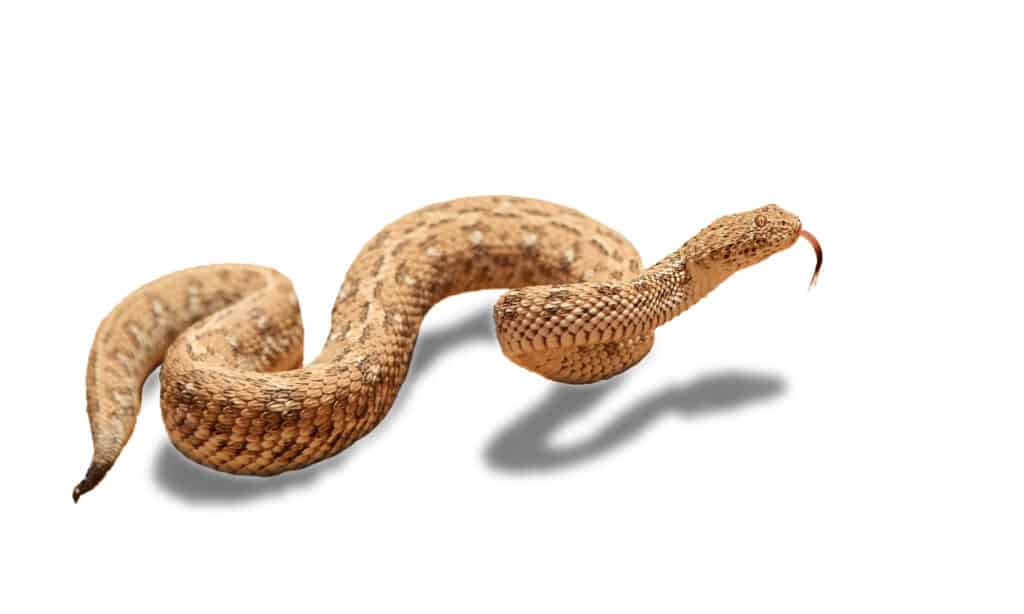
Peringuey’s adders have strongly keeled scales that collect moisture from the fog in the area.
©Martin Mecnarowski/Shutterstock.com
Pictures and Videos of Peringuey’s Adder
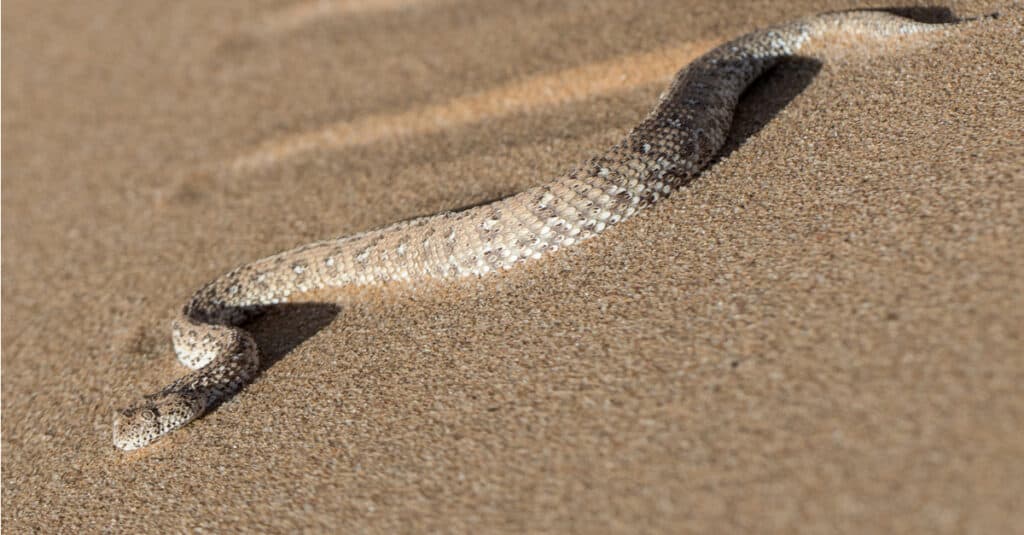
Sidewinders leave a distinct trail as they travel across the sand.
©Ken Griffiths/Shutterstock.com
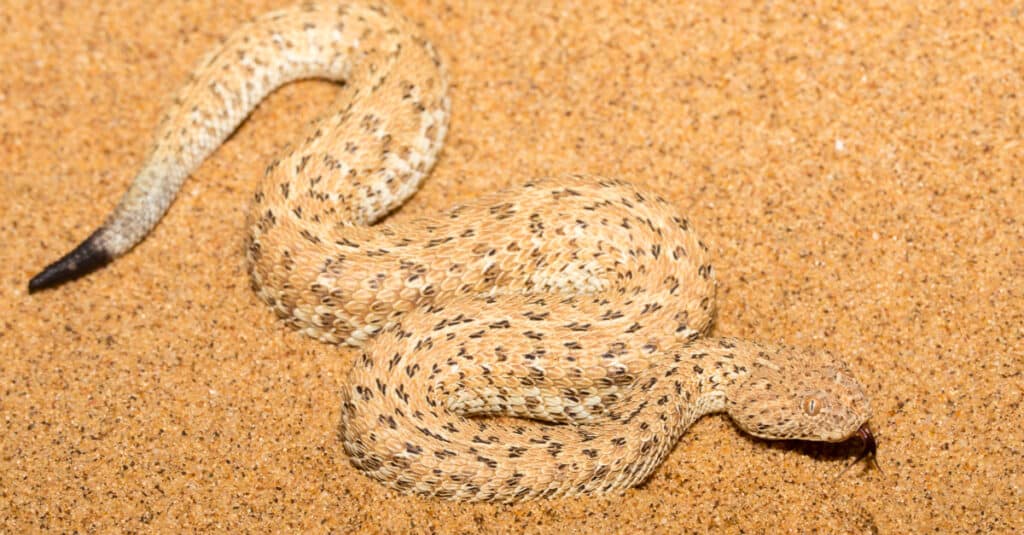
About 25% of Peringuey’s adders have black tails.
©AZ Outdoor Photography/Shutterstock.com
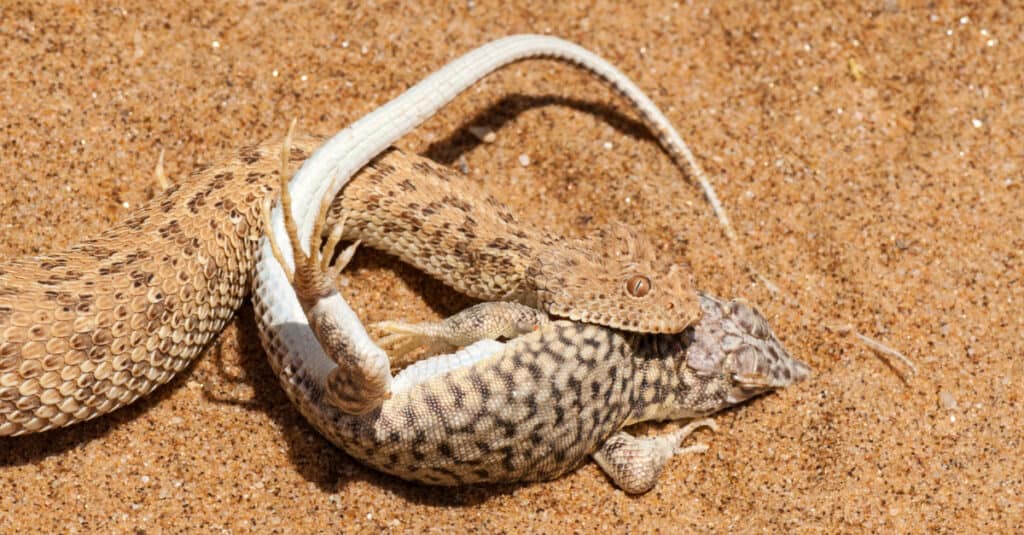
Peringuey’s adders eat nothing but lizards.
©Stefan Scharf/Shutterstock.com
Venom: How Dangerous Are Peringuey’s Adders?
Like all vipers, Periguey’s adders are venomous. They can retract their fangs via the hinging for which vipers are known, and those fangs are attached to venom glands. They’re not as dangerous as others in their genus; however, Peringeuy’s adder bites are painful. The venom is mildly cytotoxic and causes pain, swelling, and sometimes tissue death. However, these snakes aren’t responsible for any fatalities.
Peringuey’s Adder Behavior and Humans
Peringuey’s adders first flee from threats. They are fast and move at up to 18 miles per hour, so they use their speed to escape predators before they try to bite. Bites from this species are uncommon; however, most are accidental and caused because the victim stepped on the snake.
They’re not overly aggressive or cranky but defend themselves when necessary.
Similar Animals
View all 192 animals that start with PPeringuey’s Adder FAQs (Frequently Asked Questions)
Are Peringuey's adders venomous?
Yes, but like its sister species, the horned adder, its venom is mildly cytotoxic.
How do Peringuey's adders hunt?
They’re ambush predators and bury themselves in the sand until a lizard wanders by.
Are Peringuey's adders aggressive?
No, they seem far more interested in escape than attack; even when they’re disturbed they’re more likely to take off across the sand.
Where do Peringuey's adders live?
These snakes live in a small strip of land near the coast of Namibia and Angola called the Namib Desert.
What do Peringuey's adders eat?
Peringuey’s adders are specialists. They only eat lizards and geckos, and these prey animals provide most of the snakes’ water.
Thank you for reading! Have some feedback for us? Contact the AZ Animals editorial team.
Sources
- Reptile Database, Available here: https://reptile-database.reptarium.cz/species?genus=Bitis&species=peringueyi
- IUCN Redlist, Available here: https://www.iucnredlist.org/species/178627/120595367
- Coloher.org, Available here: https://coloherp.org/bitis-peringueyi/
- African Snakebite Institute, Available here: https://www.africansnakebiteinstitute.com/snake/peringueys-adder/
- Observations on the Natural History of Peringuey's Adder, Available here: https://journals.co.za/doi/epdf/10.10520/AJA00411752_206

